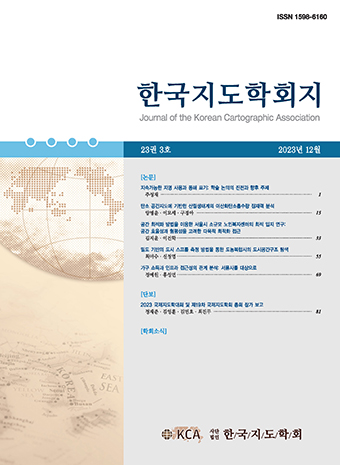Research Article
Abstract
References
Information
The main objective of this study is to provide conceptual clarifications on geovisualization for migration flow and to exemplify them with various thematic maps for internal migration data of South Korea. A spatial framework for migration studies is offered based on an in-depth discussion on the spatial scale concept. Various migration measures are properly placed on a typology table on which one dimension is about their characteristics and the other is about their spatial scales. A proper way to combine various measures and the three major types of thematic mapping, proportional symbol, choropleth, and flow maps, is examined. Thematic maps for the internal migration flow data in South Korea in 2020 are offered at three different regional scales: a kind of bivariate proportional symbol map for net migrants and net migration rates and a choropleth map for migration effectiveness at the general regional scale; a couple of proportional symbol maps and a couple of choropleth maps for row-standardization and column-standardization proportions at the region-specific level; and a couple of flow maps for stream effectiveness and dominant flows at the inter-regional scale. This study is expected to foster exploratory spatial data analysis for migration flow data beyond simple data visualization.
본 논문의 주된 연구목적은 인구이동 플로의 지리적 시각화를 위한 개념적 명료화를 수행하고, 그것에 의거해 우리나라 인구이동 데이터를 사례로 다양한 주제도의 예시를 제공하는 것이다. 공간적 스케일 개념에 대한 심도 깊은 논의를 바탕으로 인구이동 연구를 위한 공간적 프레임워크가 제시되었다. 인구이동 관련 측도들의 다양성이 측도의 성격과 측도의 공간적 스케일이라는 두 축에 의거한 유형 분류 체계를 통해 제시되었다. 측도의 다양한 성격을 세 가지 주요 주제도 유형(도형표현도, 코로플레스맵, 유선도)과 결합하는 원리가 제시되었다. 우리나라 2020년 시군구 단위 인구이동 플로 데이터에 대해 세 가지 지역 스케일별로 주제도 제작의 사례가 제공되었다. 지역별 수준에서는 순이동과 순이동률에 대한 일종의 이변량 도형표현도, 인구이동 영향력에 대한 코로플레스맵, 자족도에 대한 코로플레스맵이 제시되었다. 지역-특수적 수준에서는 행-표준화 지도와 열-표준화 지도가 도형표현도와 단계구분도의 형태로 제시되었다. 지역간 수준에서는 스트림 영향력 지도와 탁월류 분석 지도가 유선도 형태로 제시되었다. 본 연구는 단순한 시각화를 넘어 인구이동 플로 데이터에 대한 탐색적 공간데이터 분석을 진작한다는 측면에서 의의가 있는 것으로 평가된다.
- 구형모, 2018, "대학 진학 이동과 대학 졸업자 취업 이동의 공간적 특성 탐색," 한국도시지리학회지, 21(3), 109-122. http://doi.org/10.21189/JKUGS.21.3.8 10.21189/JKUGS.21.3.8
- 김감영, 2010, "연령별 인구이동 특성에 대한 탐색적 공간 데이터 분석(ESDA): 대구시를 사례로," 한국지역지리학회지, 16(5), 590-609. UCI G704-000607.2010.16.5.010
- 김감영, 2011, "공간 상호작용 모델에 대한 공간단위 수정가능성 문제(MAUP)의 영향," 대한지리학회지, 46(2), 197-211. UCI G704-000550.2011.46.2.004
- 김감영・이상일, 2012, "Web GIS 기반 유선도 작성을 통한 인구이동통계의 지리적 시각화," 대한지리학회지, 47(2), 268-281. UCI G704-000550.2012.47.2.008 10.1007/s10272-012-0428-5
- 김영호, 2010, "서울시 자전거 이용의 공간 네트워크 패턴 연구: 공간적 네트워크 자기상관을 중심으로," 국토지리학회지, 44(3), 339-352. UCI G704-001284.2010.44.3.004
- 김지우・이건학, 2017, "웹기반 데이터 시각화 도구를 활용한 플로우 데이터의 지리적 시각화 기법 탐색," 한국지도학회지, 17(1), 25-39. http://dx.doi.org/10.16879/jkca.2017.17.1.025 10.16879/jkca.2017.17.1.025
- 김현미・이상일, 2021a, "우리나라 디지털 행정구역 경계 파일의 일반화에 관한 연구: 주제도 제작용 기본도를 중심으로," 한국지도학회지, 21(2), 29-44. 10.16879/jkca.2021.21.2.029
- 김현미・이상일, 2021b, "이성분트렌드매핑 기법을 이용한 우리나라 인구 변화의 시공간적 역동성 시각화," 한국사진지리학회지, 31(3), 51-68. 10.35149/jakpg.2021.31.3.004
- 신정엽, 2005, "상이한 공간 스케일 효과와 유의한 작동 스케일(operational scale)에 대한 경험적 탐색 연구: 미국 도시중심지와 인구간 상관관계를 사례분석으로," 한국도시지리학회지, 8(2), 91-106. UCI G704-001360.2005.8.2.009
- 이건학・김감영・김영호・김영훈・신정엽・이상일 역, 2014, 「지도학과 지리적 시각화」, 서울: 시그마프레스. (Slocum, T.A., McMaster, R.B., Kessler, F.C., and Howard, H.H., 2009,
Thematic Cartography and Geovisualization , 3rd ed., Upper Saddle River: Prentice Hall.) - 이상일, 2012, "공간적 상호작용론의 본질과 연구 영역: 인문지리학에 대한 통섭적 접근," 한국지리학회지, 1(1), 137-151. UCI G704-SER000004171.2012.1.1.011 10.25202/JAKG.1.1.11
- 이상일・김감영・제갈영, 2012, "지오컴퓨테이션 접근에 의한 주택시장지역의 설정: 우리나라 수도권에의 적용," 한국도시지리학회지, 14(3), 59-75. UCI G704-001360.2012.15.3.002
- 이상일・김현미, 2021, "인구이동 플로의 연령-특수적 패턴 분석을 위한 방법론 연구 - 우리나라 시군구 단위 인구이동에의 적용 -," 대한지리학회지, 56(5), 537-550. 10.22776/kgs.2021.56.5.537
- 이상일・손일 역, 2021, 「지도와 거짓말」, 서울: 푸른길. (Monmonier, M., 2018,
How to Lie with Maps , 3rd ed., Chicago: The University of Chicago Press.) - 이상일・이소영, 2019, "우리나라 센서스 지리의 고도화를 위한 제언: 메조-스케일 공간단위의 다양화," 지리교육논집, 63, 1-13. 10.46329/LLF.2019.11.28.63
- 이소영, 2020, "교육성과에 대한 네이버후드 효과 연구에서의 공간단위 적절성 문제: MAUP를 고려한 작동스케일 탐색," 대한지리학회지, 55(6), 601-618. 10.22776/kgs.2020.55.6.601
- 이승민・이건학, 2021, "유동 클러스터 탐지 기법의 개발과 적용: 서울시 대중교통 통행을 사례로," 한국지도학회지, 21(2), 129-144. http://dx.doi.org/10.16879/jkca.2021.21.2.129 10.16879/jkca.2021.21.2.129
- 최은영・조대헌, 2005, "서울 강남구의 경제적 장벽과 인구이동 특성," 서울도시연구, 6(4), 1-20. UCI G704-001108.2005.6.4.006
- 통계청, 2021, 2020년 국내인구이동통계 결과, 보도자료, 1월 26일.
- Andrienko, G., Andrienko, N., Fuchs, G., and Wood, J., 2016, Revealing patterns and trends of mass mobility through spatial and temporal abstraction of origin-destination movement data,
IEEE Transactions on Visualization and Computer Graphics , 23(9), 2120-2136. 10.1109/TVCG.2016.2616404 - Bailey, T.C. and Gatrell, A.C., 1995,
Interactive Spatial Data Analysis , Harlow, Essex: Longman. ISBN 0-582-24493-5 - Bell, M., Blake, M., Boyle, P., Duke‐Williams, O., Rees, P., Stillwell, J., and Hugo, G., 2002, Cross‐national comparison of internal migration: Issues and measures,
Journal of the Royal Statistical Society: Series A (Statistics in Society) , 165(3), 435-464. 10.1111/1467-985X.t01-1-00247 - Bell, M., Charles‐Edwards, E., Ueffing, P., Stillwell, J., Kupiszewski, M., and Kupiszewska, D., 2015, Internal migration and development: Comparing migration intensities around the world,
Population and Development Review , 41(1), 33-58. 10.1111/j.1728-4457.2015.00025.x - Brown, P. and Hincks, S., 2008, A framework for housing market area delineation: Principles and applications,
Urban Studies , 45(11), 2225-2247. 10.1177/0042098008095866 - Chatagnier, S. and Stillwell, J., 2021, Scale and zonation effects on internal migration indicators in the United Kingdom,
Population, Space and Place , e2455. 10.1002/psp.2455 - Charles-Edwards, E., Bell, M., Bernard, A., and Zhu, Y., 2019, Internal migration in the countries of Asia: Levels, ages and spatial impacts,
Asian Population Studies , 15(2), 150-171. 10.1080/17441730.2019.1619256 - Chun, Y., 2008, Modeling network autocorrelation within migration flows by eigenvector spatial filtering,
Journal of Geographical Systems , 10(4), 317-344. 10.1007/s10109-008-0068-2 - Clayton, C., 1977, The structure of interstate and interregional migration: 1965-1970,
The Annals of Regional Science , 11(1), 109-122. 10.1007/BF01287253 - Dent, B.D., Torguson, J.S., and Hodler, T.W., 2009,
Cartography: Thematic Map Design , 6th edition, Boston: McGraw Hill. - Duke-Williams, O. and Stillwell, J., 2010, Temporal and spatial consistency, in Stillwell, J., Duke-Williams, O., and Dennett, A., eds.,
Technologies for Migration and Commuting Analysis: Spatial Interaction Data Applications , New York: Business Science Reference, 89-110. 10.4018/978-1-61520-755-8.ch005 - Fischer, M.M. and Griffith, D.A., 2008, Modeling spatial autocorrelation in spatial interaction data: An application to patent citation data in the European Union,
Journal of Regional Science , 48(5), 969-989. 10.1111/j.1467-9787.2008.00572.x - Goodchild, M.F. and Lam, N.S.N., 1980, Areal interpolation: A variant of the traditional spatial problem,
Geo-processing , 1(3), 297-312. - Goodchild, M.F., Anselin, L., and Deichmann, U., 1993, A framework for the areal interpolation of socioeconomic data,
Environment and Planning A , 25(3), 383-397. 10.1068/a250383 - Guo, D., 2009, Flow mapping and multivariate visualization of large spatial interaction data,
IEEE Transactions on Visualization and Computer Graphics , 15(6), 1041-1048. 10.1109/TVCG.2009.143 - Guo, D. and Zhu, X., 2014, Origin-destination flow data smoothing and mapping,
IEEE Transactions on Visualization and Computer Graphics , 20(12), 2043-2052. 10.1109/TVCG.2014. 2346271 - Guo, D., Zhu, X., Jin, H., Gao, P., and Andris, C., 2012, Discovering spatial patterns in origin‐destination mobility data,
Transactions in GIS , 16(3), 411-429. 10.1111/j.1467-9671.2012.01344.x - Holmes, J.H. and Haggett, P., 1977, Graph theory interpretation of flow matrices: A note on maximization procedures for identifying significant links,
Geographical Analysis , 9(4), 388-399. 10.1111/j.1538-4632.1977.tb00591.x - Kim, K., Lee, S.-I., Shin, J., and Choi, E., 2012, Developing a flow mapping module in a GIS environment,
The Cartographic Journal , 49(2), 164-175. 10.1179/174327711X13166800242356 - Koylu, C. and Guo, D., 2017, Design and evaluation of line symbolizations for origin-destination flow maps,
Information Visualization , 16(4), 309-331. 10.1177/1473871616681375 - Lam, N.S.-N., 2004, Fractals and scale in environmental assessment and monitoring, in Sheppard, E. and McMaster, R., eds.,
Scale & Geographic Inquiry: Nature, Society, and Method , Malden: Blackwell, 23-40. 10.1002/9780470999141.ch2 - LeSage, J.P. and Pace, R.K., 2008, Spatial econometric modeling of origin-destination flows,
Journal of Regional Science , 48(5), 941-967. 10.1111/j.1467-9787.2008.00573.x - MacEachren, A.M., 2004,
How Maps Work: Representation, Visualization, and Design , New York: The Guilford Press. - Maddox, C., Corcoran, J., and Liu, Y., 2013, Mapping spatial flows over time: A case study using journey- to-work data,
Journal of Spatial Science , 58(1), 147-159. 10.1080/14498596.2012.759089 - Morrill, R.L., 1988, Migration regions and population redistribution,
Growth and Change , 19(1), 43-60. 10.1111/j.1468-2257.1988.tb00461.x - Nielsen, T. and Hovgesen, H., 2008, Exploratory mapping of commuter flows in England and Wales,
Journal of Transport Geography , 16(2), 90-99. 10.1016/j.jtrangeo.2007.04.005 - Nystuen, J.D. and Dacey, M.F., 1961, A graph theory interpretation of nodal regions,
Papers and Proceedings of the Regional Science Association , 7(1), 29-42. 10.1007/BF01969070 - O'Sullivan, T., Young, G., and Maclennan, D., 2004,
Local Housing System Analysis: Good Practice Guide , Edinburgh: Communities Scotland. - Pandit, K., 1994, Differentiating between subsystems and typologies in the analysis of migration regions: A US example,
The Professional Geographer , 46(3), 331-345. 10.1111/j.0033-0124.1994.00331.x - Plane, D.A., 1984, Migration space: Doubly constrained gravity model mapping of relative interstate separation,
Annals of the Association of American Geographers , 74(2), 244-256. 10.1111/j.1467-8306.1984.tb01451.x - Plane, D.A., 1994, The wax and wane of interstate migration patterns in the USA in the 1980s: A demographic effectiveness field perspective,
Environment and Planning A , 26(10), 1545-1561. 10.1068/a261545 - Plane, D.A. and Rogerson, P.A., 1994,
The Geographical Analysis of Population with Applications to Planning and Business , New York: John Wiley & Sons. - Rae, A., 2009, From spatial interaction data to spatial interaction information? Geovisualisation and spatial structures of migration from the 2001 UK census,
Computers, Environment and Urban Systems , 33(3), 161-178. 10.1016/j.compenvurbsys.2009.01.007 - Song, C., Pei, T., Ma, T., Du, Y., Shu, H., Guo, S., and Fan, Z., 2019, Detecting arbitrarily shaped clusters in origin-destination flows using ant colony optimization,
International Journal of Geographical Information Science , 33(1), 134-154. 10.1080/13658816.2018.1516287 - Stephen, D.M. and Jenny, B., 2017, Automated layout of origin-destination flow maps: US county-to-county migration 2009-2013,
Journal of Maps , 13(1), 46-55. 10.1080/17445647.2017.1313788 - Stillwell, J. and Harland, K., 2010, Analysing interaction data, in Stillwell, J., Duke-Williams, O. and Dennett, A., eds.,
Technologies for Migration and Commuting Analysis: Spatial Interaction Data Applications , New York: Business Science Reference, 69-88. 10.4018/978-1-61520-755-8.ch004 - Stillwell, J., Dennett, A., and Duke-Williams, 2010, Interaction data: definition, concepts and sources, in Stillwell, J., Duke-Williams, O. and Dennett, A., eds.,
Technologies for Migration and Commuting Analysis: Spatial Interaction Data Applications , New York: Business Science Reference, 1-30. 10.4018/978-1-61520-755-8.ch001 - Stillwell, J., Daras, K., and Bell, M., 2018, Spatial aggregation methods for investigating the MAUP effects in migration analysis,
Applied Spatial Analysis and Policy , 11(4), 693-711. 10.1007/s12061-018-9274-6 - Stillwell, J., Duke-Williams, O., and Dennett, A., eds., 2010,
Technologies for Migration and Commuting Analysis: Spatial Interaction Data Applications , New York: Business Science Reference. 10.4018/978-1-61520-755-8 - Tao, R. and Thill, J.C., 2016, Spatial cluster detection in spatial flow data,
Geographical Analysis , 48(4), 355-372. 10.1111/gean.12100 - Tao, R. and Thill, J.C., 2019, FlowAMOEBA: Identifying regions of anomalous spatial interactions,
Geographical Analysis , 51(1), 111-130. 10.1111/gean.12161 - Vrotsou, K., Fuchs, G., Andrienko, N., and Andrienko, G., 2017, An interactive approach for exploration of flows through direction-based filtering,
Journal of Geovisualization and Spatial Analysis , 1(1), 1-15. 10.1007/s41651-017-0001-7 - Wang, F., Chen, W., Zhao, Y., Gu, T., Gao, S., and Bao, H., 2017, Adaptively exploring population mobility patterns in flow visualization,
IEEE Transactions on Intelligent Transportation Systems , 18(8), 2250-2259. 10.1109/TITS.2017.2711644 - Wood, J., Dykes, J., and Slingsby, A., 2010, Visualisation of origins, destinations and flows with OD maps,
The Cartographic Journal , 47(2), 117-129. 10.1179/000870410X12658023467367 - Xiao, N. and Chun, Y., 2009, Visualizing migration flows using kriskograms,
Cartography and Geographic Information Science , 36(2), 183-191. 10.1559/152304009788188763 - Yan, J. and Thill, J.C., 2009, Visual data mining in spatial interaction analysis with self-organizing maps,
Environment and Planning B: Planning and Design , 36(3), 466-486. 10.1068/b34019 - Zhou, Z., Meng, L., Tang, C., Zhao, Y., Guo, Z., Hu, M., and Chen, W., 2018, Visual abstraction of large scale geospatial origin-destination movement data,
IEEE Transactions on Visualization and Computer Graphics , 25(1), 43-53. 10.1109/ TVCG.2018.2864503 - Zhu, X. and Guo, D., 2014, Mapping large spatial flow data with hierarchical clustering,
Transactions in GIS , 18(3), 421-435. 10.1111/tgis.12100
- Publisher :The Korean Cartographic Association
- Publisher(Ko) :한국지도학회
- Journal Title :Journal of the Korean Cartographic Association
- Journal Title(Ko) :한국지도학회지
- Volume : 21
- No :3
- Pages :23-42
- DOI :https://doi.org/10.16879/jkca.2021.21.3.023



 Journal of the Korean Cartographic Association
Journal of the Korean Cartographic Association





